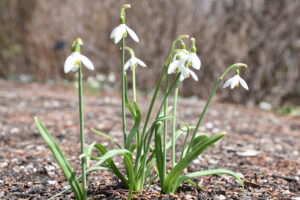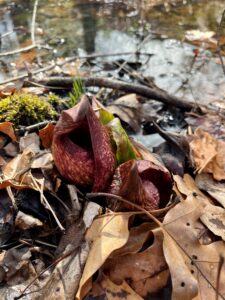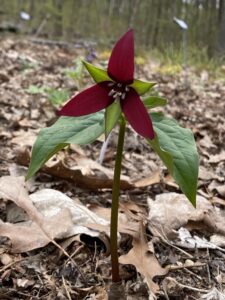By Liz Nye, New England Botanic Garden Staff
April 2023
There’s nothing quite as cheer-inducing as finding the sunny blooms of winter aconite (Eranthis hyemalis) suddenly dotting an otherwise dreary late winter garden. Well into March, these buttercup relatives in the Ranunculaceae family continue to pop up and, if allowed to spread, form a colony of happy looking yellow-orange blossoms. Paired with the lengthening days, the year’s first flowers have the power to prompt a major shift in perspective for many people. Winter is now in the rearview—for the most part.
But despite how it can feel, spring’s early blooming plants don’t come into flower simply to fill us humans with joy. These plants are opportunists, and now is their moment. All across New England’s gardens, forests, wetlands, and meadows, the plants leading the charge into spring possess enterprising adaptations that enable them to make the most of the warmer temperatures and the increasing amount of light energy available from the sun. While other plants are still dormant, the earliest of spring’s early flowering plants get a head start.

Snowdrops (Galanthus)
Anti-Freeze Flowers
Snowdrops (Galanthus) are among the many early bloomers synonymous with spring in New England, despite being non-native to the region. These bulbous perennials, widely planted in gardens alongside crocuses and daffodils, originate in the high-altitude environments of Europe and southwestern Asia. Their nodding https://zacasinosonline.co.za/high-roller-online-casinos/ white flowers and wispy green foliage only look delicate. Essentially alpine plants, snowdrops are well equipped to face the cold thanks to proteins in their tissues that protect their cells from damage. This adaptation, shared by overwintering plants and some animals like wood frogs, works like a natural antifreeze. Snowdrop flowers, which can emerge and bloom in February, persist for several weeks despite lingering snow, ice, and below freezing temperatures. Even if hit with a late winter storm, these resilient plants don’t stay down long.

Skunk cabbage (Symplocarpus foetidus)
Built-in Heaters
While snowdrops are busy withstanding the cold, other plants have what it takes to bring about the thaw. March in New England means skunk cabbage (Symplocarpus foetidus) erupts from the leaf litter alongside creek beds and swampy forests. This native perennial possesses an interesting adaptation perfect for its early spring emergence. Its inflorescence, a knob-like flower also known in botanical terms as a spadix, produces its own heat. Growing within the shelter of a hood-shaped leaf (or spathe), the spadix of a skunk cabbage can reach and even exceed 70 degrees Fahrenheit, melting the surrounding snow and ice as it flowers.
Heat production in plants is a rare adaptation. Called thermogenesis, it occurs when hormones trigger mitochondria in the flower to start burning sugars. Plants that can turn stored energy into heat this way are typically members of the Araceae family. One of the most famous thermogenic plants of this family hails from the tropical rainforests of Sumatra and Indonesia, and it is also notorious as one of the foulest smelling—the corpse flower (Amorphophallus titanum). For both the corpse flower and skunk cabbage, heat helps carry the scent of its flower to pollinators that find the rank smell enticing. Here in New England, these include flies and carrion beetles, insects that are important to the overall health of the ecosystem this season and year-round.
Poised for the Sprint
As March turns into April, some of spring’s most beautiful opportunists emerge. Native to New England’s deciduous forests, wildflowers known as spring ephemerals demonstrate that time is truly of the essence this season. As soon as the threat of snow passes, these plants produce leaves, flower, set seed, and then retreat. The process can be so quick that some blooms last no longer than a day. This incredibly short growth cycle is nature’s best strategy for beating trees like maple, ash, and cherry to resources from the sun. Once these large trees leaf out and fill the overstory, the foliage of spring ephemerals dies back. The plants then spend the rest of their lives underground where their rhizomes, corms, and tubers store the resources they need to emerge again the next year.

Red wakerobin (Trillium erectum)
Though the window for ephemeral wildflowers is narrow, while it’s open, these plants play a vital role in the forest ecosystem. Flowers provide nectar and pollen to native bees and other insects as they emerge from overwintering nest sites. Wildflower seeds also serve as a food source. Seeds come equipped with eliasome, fleshy components rich in lipids and proteins that attract ants who aid in seed dispersal by carting these tasty morsels off to their colonies.
New England is home to a variety of exquisite ephemerals—four kinds of trillium (Trillium spp.), bloodroot (Sanguinaria canadensis), trout lily (Erythronium americanum), spring beauty (Claytonia virginica), Dutchman’s breeches (Dicentra cucullaria), and more. But the same adaptations that help these ephemerals thrive make sightings by people rare. Populations are tough to discover since these plants spend most of the year below ground. They can also be slow to establish. After disturbances in their environment, some ephemerals take several years or even decades to reemerge. Native ephemerals also face a host of threats from invasive plants to human activity, habitat destruction, and climate change. That’s one reason why land conservation and preservation efforts couldn’t be more important!
This spring, follow the Garden on social media as we track the progress of all your favorite early blooms—and those mid and late season flowers, too! And as you enjoy the season, remember, it took millennia for plants to evolve the beautiful flower forms and interesting adaptations that wow us and bring us so much joy today.
Liz Nye is the Public Relations Manager at New England Botanic Garden. She holds a master’s degree in science writing from Johns Hopkins University and enjoys learning about and writing about all things plants.
